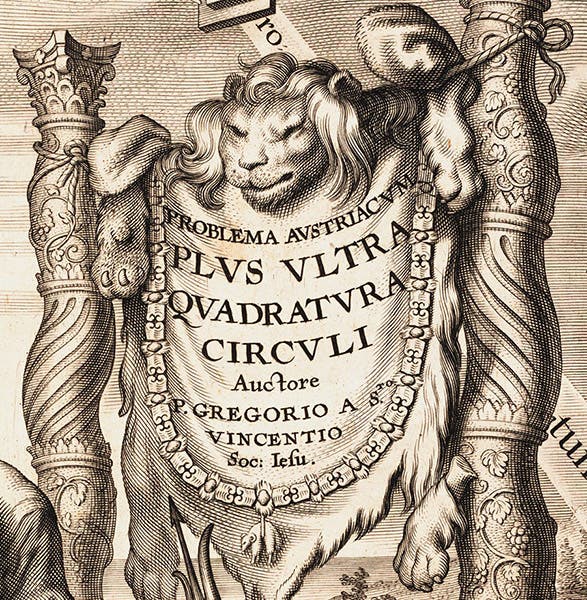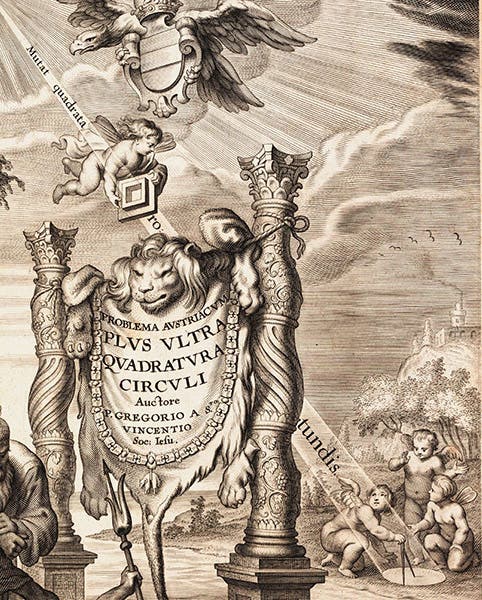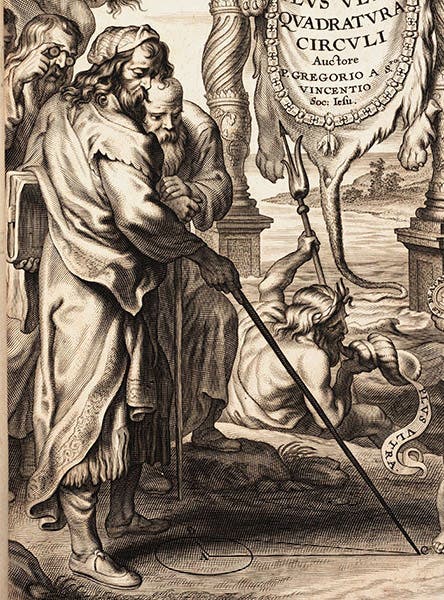Scientist of the Day - Grégoire-de-Saint-Vincent
Grégoire de Saint-Vincent, a Flemish Jesuit mathematician, died June 5, 1667, at the age of 82. He is sometimes referred to as Gregorius a Sancto Vincentio. He joined the Jesuit order (the Society of Jesus) when he was 21, and spent the initial part of his career in Louvain, and then Antwerp, where he shared the teaching load with François d'Aguilon, who had recently published his influential treatise on optics. In the 1620s, Grégoire began working on the problem of squaring the circle, a rather hot topic in mathematical circles in the early 17th century, and he thought he had succeeded. He tried to get permission from Christoph Grienberger, the Jesuit mathematical censor in Rome, to publish his book, but permission was refused, for reasons unknown to me. The book would only be published 20 years later, in 1647, after Grienberger had died. It is a beautiful, if thick and forbidding, volume, called: Problema austriacum plus ultra: Quadratura circuli, published in Antwerp, and containing almost 1300 folio pages on the topic of quadrature, turning things into squares using geometrical means.
Since we now know that it is impossible to square the circle – to convert a circle to a square using the principles of Euclidean geometry – that means Saint-Vincent went astray in his proof. Since I am not competent to explain where he went wrong, let us turn to a different aspect of his book, which I am better qualified to discuss: the engraved title page. The Jesuits were well known for including illustrated title pages as integral parts of their scientific publications. We have shown and occasionally discussed some of these in previous posts on 17th-century Jesuit scientists: the above mentioned Aguilon, Christoph Scheiner, Niccolo Zucchi, André Tacquet, to mention just a few. The engraved title page to Saint-Vincent's work is one of the finest examples of Jesuit emblematic imagery, both in its conception, and its execution. Let me point out a few of its interesting features, and show you some details.
The book is called The Austrian Problem because it is dedicated to the House of Austria (see the title panel, second image). The phrase Plus ultra (further) was the motto of the most famous early Habsburg Emperor, Charles V, and the double-headed eagle was the emblem of the Habsburgs. The device of Charles V included the pillars of Hercules, i.e., the straits of Gibraltar, and the motto meant that we can go further than ancient mariners and sail beyond the pillars of Hercules to discover the unknown. Francis Bacon had used the same motif on the frontispiece to his Novum organum (1620), which you can see as the first image at out post on Bacon.
Since the Problema austriacum is about squaring the circle, it is not surprising that we have several representations of that theme. A putto at the top holds a square aperture at the top, and his co-putti on the ground are surprised to see that it casts a circular image of the Sun – circling the square, as it were (third image). Along the sunbeam is the phrase: Mutat quadrata rotundis – “it changes circles to squares," which is an extract from the First Epistle of Horace, which in fuller form reads: “my judgment contradicts itself, strives for what it rejects, fetches back what it has recently abandoned, is in disarray in respect to all of life's order, and makes them destroy, build, and change squares into circles.” You are presumed to have a good classical education when you are confronted with an allegorical or emblematic title page.
On the left side, several scholars (one wearing glasses) observe Archimedes pointing at a diagram on the ground (fourth image). We presume it is Archimedes, because the figure represents one of his proofs, in his treatise On the Circle, that the area of a circle is equal to the area of a triangle whose one side is the radius of the circle and the other the circumference. Archimedes was not squaring the circle, but he was showing how to triangulate one.
Finally, at bottom right, two putti stand behind a globe sitting on a cube, with the motto Mobile fit fixum – “the moveable is made fixed” – written on the two shapes (fifth image). This is an emblem, taken right out of an emblem book, with the same motto. In addition, both putti hold coins – actually two sides of the same coin – which dates to the reign of Constantinus. On the verso of the coin is the motif of the sphere on the cube, with the motto, beata tranquilitas – “happy tranquility”, as the tendency of the sphere to roll has been tamed. It is a good motto for an emperor, whose task is to bring stability to what is inherently unstable. This coin was a real coin, and I own a specimen, with the sphere atop the cube on the back. I tried to photograph it, but it is very worn – it is 1600 years old – and the relief is difficult to capture. I shall have to have it professionally scanned.
You might have noticed that the detail of the putti at bottom right also shows us the name of the artist, Abraham van Diepenbeek, and the engraver, Cornelius Galle the Younger. These were two of the very best working in Antwerp, for the Jesuits never tried to cut costs with their imagery. We presume that Diepenbeek, in his drawing, was echoing Saint-Vincent's wishes, because the dedication by Saint-Vincent to the House of Austria contains a detailed explication of the meaning of the engraved title page.
There is no portrait of Saint-Vincent in his book, and only two turn up in online searches. We choose the older, an engraving of the late 17th century. Wikipedia chose the other one, from the 1890s. The two look nothing alike, so you may take your choice, or reject them both, and opt perhaps for one of the men next to Archimedes, looking at his diagram in the sand.
William B. Ashworth, Jr., Consultant for the History of Science, Linda Hall Library and Associate Professor emeritus, Department of History, University of Missouri-Kansas City. Comments or corrections are welcome; please direct to ashworthw@umkc.edu.









![Andromeda and Perseus, constellations figured by James Thornhill, with star positions determined by John Flamsteed, in Atlas coelestis, plate [15], 1729 (Linda Hall Library)](https://assets-us-01.kc-usercontent.com:443/9dd25524-761a-000d-d79f-86a5086d4774/1b30cfec-5be6-4297-a7fb-97255ba992e5/thornhill1.jpg?w=210&h=210&auto=format&fit=crop)


